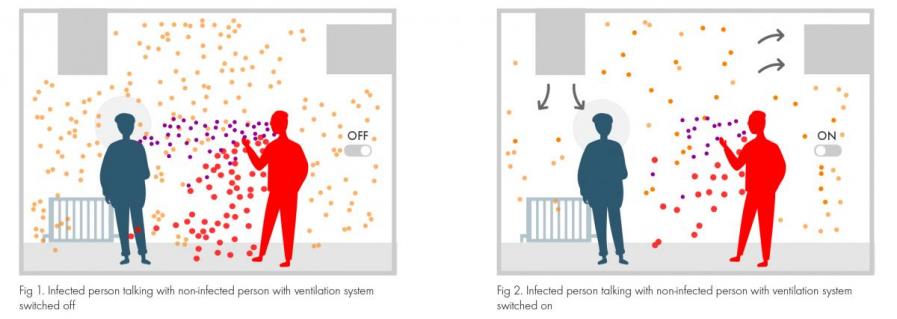Published: 19/11/2020
Vent-Axia has welcomed the launch of the Government’s new public information campaign which highlights how ventilating indoor spaces can reduce the risk of coronavirus infection by over 70%1. As part of the campaign a new short film released by the Government shows how coronavirus lingers in enclosed spaces, and how to keep your home ventilated. The campaign follows The World Health Organisation (WHO) recently acknowledging that ‘Ventilation represents a very important factor to prevent the virus from spreading indoors,”2 having updated its guidance to recognising the possibility of airborne transmission on 9th July.3 Public Health England’s guidance ‘COVID-19: epidemiology, virology and clinical features’4 also recently acknowledged that airborne transmission can occur in ‘poorly ventilated’ spaces.
Vent-Axia has praised the Government’s new Public Health information campaign since the company has seen first-hand how ventilation has helped fight the virus. The leading British ventilation manufacturer has helped in the national response against COVID-19 by supplying ventilation to a number of COVID hospital wards and field hospitals, including the NHS Nightingale Hospital in London and the Rainbow hospitals.

The Government’s campaign, forms part of its wider ‘Hands. Face. Space’ guidance, and includes the new short film created with scientists and an engineer at Leeds University. Professor Catherine Noakes, Leeds University, was an adviser for the short film and, said: “When a room does not have any fresh air, and where people are generating large amounts of aerosol through activities such as singing and loud speech, that is when transmission of coronavirus is most likely. Fresh air must come from outdoors – recirculating air just means the aerosols containing the virus move around the same room rather than being extracted outdoors.
“Ventilation units or any household systems that use outdoor air can be just as effective as opening windows or doors as long as they are limiting the recirculation of the same air.”5
The short film illustrates how in enclosed spaces where there is no fresh air coronavirus stays in the air, increasing the risk of people breathing in infected virus particles. This risk can be reduced significantly by regularly ventilating enclosed areas with the film advising that using extractor fans in bathrooms and kitchens more frequently will remove particles more quickly.
“A raft of global scientific evidence has confirmed airborne transmission, making it a higher risk to be inside a building than outside. Research has now shown that being in a well-ventilated room can reduce the risk of infection from virus particles by over 70%. To lower the risk of COVID-19 transmission inside a home or building it is therefore vital to increase airflow and ventilate effectively. Now is the time to check ventilation to ensure there is enough airflow to dilute the virus in the air and improve indoor air quality. Ventilating for longer and opting for ventilation with higher airflow volumes will help reduce the risk. At Vent-Axia we are here if households or businesses need advice on ventilation.” said Jenny Smith, Head of Marketing at Vent-Axia. 
As the weather cools we are all spending more time inside. The Government campaign therefore advises ventilating rooms regularly either by opening windows for short, sharp bursts of 10-15mins throughout the day or by leaving a window slightly open continuously. This will help remove any virus particles in the air. It is also advised that kitchen or bathroom extractors are used regularly as another way to remove virus particles.
It is particularly important to air a room when a household has had visitors, tradespeople, carers or someone in their support bubble visiting. It is also vital to ensure good ventilation if someone in the family has the virus to prevent it spreading to other members of the household.
Although originally it was thought the main mode of virus transmission was fomite transmission it has now been confirmed that Coronavirus is also spread by aerosols that are exhaled from the nose and mouth of an infected person as they breathe, speak or cough. The majority of virus transmissions happen indoors. Being indoors, with no fresh air, the particles can remain suspended in the air for hours and build up over time. Plus, the longer people spend in the same room as these particles, the more likely they are to be infected.
Vent-Axia was recently named a UK Business Hero by the UK Chamber of Commerce for going the extra mile during the Coronavirus outbreak by supplying ventilation to critical projects and providing expert ventilation information through its ‘COVID-19 Support Campaign’.
Vent-Axia is continuing to offer support and ventilation expertise to help in the fight against Coronavirus and has recently launched a webpage and brochure offering essential guidance on the positive effect of ventilation in tackling COVID-19. Bringing together all the helpful information that it has been communicating since the start of lockdown in March, the useful guide and webpage provides the industry with valuable information on how ventilation can help during the pandemic and beyond - all in one place. The webpage and brochure, called ‘'The Effect of Ventilation on COVID-19’ explains the benefits of ventilation during the COVID-19 pandemic and gives guidance on why indoor ventilation is important to reduce virus transmission. Visit https://www.vent-axia.com/dilutethevirus to find out more and to download the free brochure.
For further information on all products and services offered by Vent-Axia telephone 0344 856 0590.
- 1. SAGE EMG paper, ‘Role of Ventilation in Controlling SARS-COV2 Transmission’. The value of 70% is based on modelled risks within table 3 in the EMG paper. Increasing the ventilation rate from 1 litre per second per person (very low ventilation rate) to 10 litres per second per person (recommended ventilation rate in standards for many buildings) gives a reduction in relative risk between 68% and 86% depending on the viral emission rate and the duration of exposure. This is based on models and is subject to uncertainties. However, the relative influence of ventilation on the removal of airborne contaminants is well understood.
2. ‘WHO's Science in 5 on COVID-19 – Ventilation’, October 29th 2020, Episode #10 How important is ventilation and how does it keep you safe from COVID-19? WHO’s Dr Maria Neira.
3. ‘‘Transmission of SARS-COV-2: implications for infection prevention precautions’ published by WHO on 9 July 2020.
4. Public Health England’s guidance ‘COVID-19: epidemiology, virology and clinical features’.
5. Department of Health and Social Care Press Release, issued on 18 November 2020, ‘New Film Shows Importance of Ventilation to Reduce Spread of COVID-19’.
6. Boasting over 80 years’ experience, Vent-Axia is the ventilation sector’s clear leader, chief innovator and forerunner in developing energy efficient products that help provide good indoor air quality. Committed to improving indoor air quality and comfort in both homes and buildings, Vent-Axia provides the sector’s most comprehensive choice from any single manufacturer. Vent-Axia’s range covers not just air movement and ventilation technologies but heat recovery, electric heating, hand dryers, cooling and clean-air systems for residential, commercial, public sector and industrial applications.